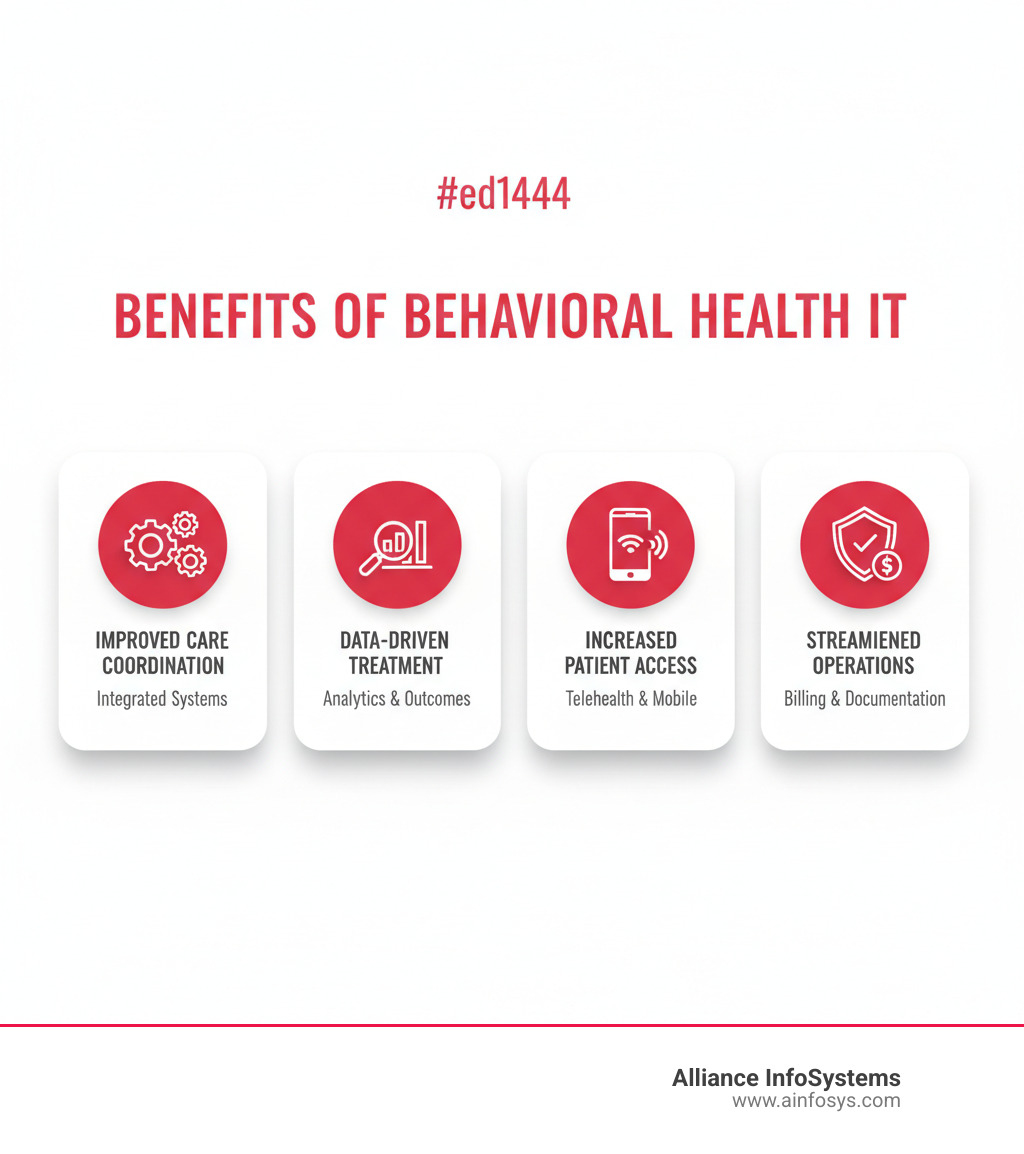Why Behavioral Health IT Matters Now More Than Ever
Behavioral health IT integrates technology like electronic health records (EHRs), telehealth, and data analytics into mental health and substance use treatment. These tools help providers coordinate care, track progress, manage billing, and improve access to services. Key components include specialized EHRs, telehealth platforms, mental health apps, analytics tools, and compliance features for standards like HIPAA and 42 CFR Part 2.
The demand for behavioral health services has surged, particularly since the COVID-19 pandemic. However, providers in this field have historically lagged in technology adoption. Federal data shows only 67 percent of psychiatric hospitals have adopted certified EHRs, compared to 86 percent of general acute care hospitals. This gap is due to limited funding, challenges in quantifying outcomes, and a lack of incentives that were available to other medical specialties.
Fortunately, the tide is turning. Federal agencies are now committing $20 million over three years through the Behavioral Health Information Technology (BHIT) Initiative to advance technology adoption, standardize data, and improve interoperability. For behavioral health organizations, this presents a significant opportunity. The right IT systems can transform care, but successful implementation requires careful planning, robust security, and expert support.
The Core Components of Modern Behavioral Health Technology
The Behavioral health IT ecosystem includes Electronic Health Records (EHRs), mental health apps, telehealth platforms, and patient engagement portals. For these tools to be effective, they must work in harmony, allowing therapists, psychiatrists, and primary care physicians to access the same information at the right time. This coordination is essential for effective treatment. Why is it important to manage behavioral health services? Patient portals further improve care by giving individuals an active role in tracking progress and communicating with providers.
Key Features of Specialized Behavioral Health IT Systems
Unlike general medical software, specialized behavioral health EHRs are designed for the unique needs of mental health treatment.
- Narrative documentation: These systems support the detailed, story-based nature of mental health records with flexible templates for SOAP or DAP notes, as well as group and family session documentation.
- Complex billing: Specialized EHRs streamline complex CPT codes, time-based billing rules, and prior authorizations, helping providers generate clean claims and reduce administrative burdens.
- Care coordination: For fields like Applied Behavior Analysis, secure messaging and shared access to client records are vital for multidisciplinary teams to stay aligned.
- Compliance features: These systems are built to handle strict privacy rules beyond HIPAA, including 42 CFR Part 2 for substance use disorder records. This is managed through granular access controls and detailed audit logs.
The Rise of Mental Health Apps and Digital Therapeutics
Mental health apps offer convenience, anonymity, and low-cost access to support. The best apps function as self-management tools for tracking moods, practicing mindfulness, or working through cognitive behavioral therapy techniques. Some even use passive symptom tracking to detect early warning signs of a worsening condition.
However, the app market is largely unregulated, raising concerns about effectiveness and data privacy. Many apps lack peer-reviewed research and may have security vulnerabilities. To choose a trustworthy app:
- Look for apps that are evidence-based and developed with clinical experts. You can search for studies on PubMed or clinical trial databases.
- Read the privacy policy to understand how your data is used.
- Ensure the app has a clear crisis protocol that directs users to resources like the 988 Suicide and Crisis Lifeline.
- Prioritize apps recommended by trusted healthcare professionals, as they are best used to complement, not replace, professional care.
Government Initiatives and Data Standards Shaping the Future
The federal government is now actively working to close the technology gap in Behavioral health IT. For years, behavioral health providers were largely excluded from incentives like the HITECH Act, which helped the rest of healthcare modernize.
The Substance Abuse and Mental Health Services Administration (SAMHSA) and the Office of the National Coordinator for Health Information Technology (ONC) have launched the Behavioral Health Information Technology (BHIT) Initiative. Backed by $20 million over three years, this program aims to make health IT more affordable and functional for behavioral health providers, reducing the burden of data capture and improving interoperability between systems. This is a crucial step toward integrating behavioral health into the broader Healthcare ecosystem. You can read more in The SAMHSA and ONC Behavioral Health Information Technology Initiative.
The USCDI+ and Standardizing Behavioral Health Data
A key part of the BHIT Initiative is creating a framework for data standardization through the United States Core Data for Interoperability (USCDI). Think of USCDI as a universal translator for health data. The initiative is piloting a USCDI+ domain for behavioral health to create standardized ways to capture and share information unique to mental health and substance use treatment.
This data harmonization will lead to:
- Improved data exchange: Seamless sharing of information between therapists, primary care doctors, and other providers.
- Reduced provider burden: Less time spent on manual data entry and tracking down patient history from incompatible systems.
- Better quality measurement: The ability to track outcomes against benchmarks like HEDIS (Healthcare Effectiveness Data and Information Set) to demonstrate program effectiveness.
By involving clinicians in pilot programs, the initiative ensures that these new standards will be practical for real-world settings. For organizations planning to modernize their IT, these federal initiatives provide a clear roadmap for the future of Behavioral health IT.
The Evolving Landscape of Behavioral Health IT: Benefits and Problems
Implementing Behavioral health IT presents both transformative opportunities and significant challenges.
On the benefits side, the positive impacts are clear:
- Integrated care: A holistic view of the patient is created when a therapist, psychiatrist, and primary care doctor can all see the same information.
- Accessibility: Telehealth and mobile apps remove geographical and transportation barriers to care.
- Data-driven insights: Systematically tracking outcomes helps providers make evidence-based treatment decisions.
- Streamlined operations: Automation for billing and documentation frees up more time for patient care.
- Improved compliance: Automated tools reduce the burden of meeting complex regulatory requirements.
However, challenges remain. Data privacy is a major concern with sensitive mental health information. Implementation costs can be prohibitive for smaller practices, and the digital divide means not all patients have equal access to technology. Furthermore, a historical lag in adoption (67% in psychiatric hospitals vs. 86% in general acute care) reflects systemic issues like underfunding and stigma. Clinicians may also resist new systems they fear will increase their administrative burden.
Overcoming Challenges in Behavioral Health IT Implementation
Addressing these challenges requires a strategic approach custom to each organization’s needs.
- Data quantification: While behavioral health progress is often narrative, it can be quantified by integrating patient-reported outcome measures (like PHQ-9 for depression) directly into the EHR.
- Privacy and consent: Go beyond standard HIPAA compliance to meet the stricter requirements of 42 CFR Part 2 for substance use records. This requires granular access controls, detailed audit logs, and strong Data Security to build patient trust.
- The digital divide: Overcome access issues through community partnerships, hybrid care models, and app design that functions in low-bandwidth environments.
- Clinician buy-in: Achieve adoption by choosing user-friendly platforms, providing comprehensive training, and demonstrating how technology improves patient care and saves time.
- Reimbursement limitations: Advocate for policy changes and value-based care models that reward the use of digital health services.
- Business continuity: Implement a solid Data Backup and Recovery plan to protect patient data and ensure continuity of care during any disruption.
Success requires collaboration between clinicians, IT professionals, policymakers, and patients. An experienced IT partner can help steer these technical and human requirements.
Emerging Trends: AI and Analytics in Behavioral Health
Artificial Intelligence and advanced analytics are fundamentally changing Behavioral health IT. Rather than replacing the human connection in therapy, AI is augmenting clinicians’ abilities by using Natural Language Processing (NLP) and machine learning to identify patterns that might signal a patient’s risk or response to treatment.
Predictive analytics is one of the most powerful applications, enabling providers to identify patients at high risk of relapse or crisis. This allows for a shift from reactive management to proactive, preventive care. AI also facilitates personalized care by analyzing vast datasets to help tailor treatment plans to an individual’s unique history and characteristics. The Cloud Computing infrastructure is essential for processing the massive datasets these AI systems require.
The Impact of AI on Treatment and Provider Workflows
In daily practice, AI is making a significant impact in several ways:
- Automated documentation: NLP can analyze session transcripts to generate draft documentation, reducing administrative work and freeing up clinicians to focus on patients.
- Sentiment analysis: AI can detect subtle changes in a patient’s speech or text that may indicate worsening depression or anxiety, triggering alerts for clinicians.
- AI-powered chatbots: Virtual assistants can handle initial assessments, guide patients through self-help exercises, and provide 24/7 support, acting as a bridge to professional care.
- Real-time monitoring: By integrating data from wearables and mobile apps (tracking sleep, activity, and mood), AI can create a dynamic picture of a patient’s well-being, offering valuable insights for treatment adjustments.
- Optimized workflows: AI helps practices run more efficiently through smarter scheduling, resource allocation, and caseload management.
These technologies are reshaping the market, driven by the demand for remote care and value-based models. With robust Business Continuity planning, organizations can ensure these advanced systems remain resilient and available.
Frequently Asked Questions about Behavioral Health IT
Navigating Behavioral health IT can be complex. Here are answers to some of the most common questions we hear from providers.
What are the main features of behavioral health software systems?
Purpose-built behavioral health software includes features designed for the unique workflows of mental health and substance use treatment. Key features include:
- Customizable progress notes: Flexible templates for various note formats (SOAP, DAP, etc.) and specialized documentation for group or family therapy.
- Integrated care and crisis planning: Tools that allow multidisciplinary teams to collaborate on comprehensive treatment and crisis plans.
- Complex billing and authorization management: Streamlined workflows for CPT codes, time-based billing, and prior authorizations to reduce errors and accelerate reimbursement.
- Secure messaging and collaboration tools: Confidential communication channels for care teams, patients, and external providers.
- Robust compliance features: Adherence to both HIPAA and the stricter 42 CFR Part 2 regulations for substance use records, including granular access controls and detailed audit logs.
- Real-time data dashboards and reporting: Tools to track client outcomes, staff performance, and program fidelity for quality improvement and reporting.
- Patient engagement portals: Secure portals for clients to schedule appointments, access resources, and communicate with their care team.
- Mobile accessibility: Cloud-based solutions that allow providers to access critical information from any location.
How can providers choose a trustworthy mental health app?
With thousands of unregulated apps on the market, it’s crucial to recommend them based on evidence, not marketing. Here’s a straightforward guide:
- Verify clinical input: Choose apps developed with input from mental health professionals or academic institutions.
- Look for evidence: Check if the app’s effectiveness is supported by peer-reviewed research. Search databases like PubMed for studies.
- Review the privacy policy: Understand what data is collected, how it’s stored, and if it’s shared with third parties.
- Check for crisis protocols: A trustworthy app must provide clear, immediate guidance for users in a crisis, directing them to resources like the 988 Suicide and Crisis Lifeline.
- Evaluate user experience: An app is only effective if patients will use it consistently. It should be engaging and easy to steer.
- Be wary of quick fixes: Avoid apps that make unrealistic promises. Real progress takes time.
- Consult expert guides: Use resources like One Mind PsyberGuide for independent reviews.
Remind patients that apps are best used as a tool to support professional care, not replace it.
Why is integrating behavioral and physical health data so important?
The mind and body are deeply interconnected. Integrating behavioral and physical health data is essential for treating the whole person, not just isolated symptoms.
- It provides a holistic view: Integration allows providers to understand how mental health conditions like depression can affect chronic physical illnesses like diabetes, and vice-versa.
- It leads to better care coordination: When the entire care team shares relevant information (with proper permissions), they can avoid conflicting medications and create unified treatment plans.
- It improves health outcomes: A whole-person approach leads to better management of chronic diseases, fewer hospital readmissions, and improved quality of life.
- It helps reduce stigma: Including behavioral health in primary care settings and shared records helps normalize mental health as a key component of overall health.
- It increases efficiency: Integrated data streamlines workflows, reduces administrative tasks, and helps allocate resources more effectively, ultimately lowering costs.
Integration breaks down the artificial walls between mental and physical healthcare, leading to more comprehensive and effective treatment.
Conclusion
Behavioral health IT is changing mental health and substance use treatment. From specialized EHRs to AI-powered analytics, technology offers the promise of better care coordination, data-driven insights, and greater access to services. These are not just small improvements; they are fundamental shifts in how care is delivered.
However, the path forward has challenges, including the need for ironclad data privacy, high implementation costs, and the digital divide. Overcoming these problems requires careful planning and strategic investment. With federal support like the BHIT Initiative, it’s clear that technology is the future of behavioral healthcare. Organizations that accept this evolution will be best positioned to serve their communities.
Having the right IT partner is critical. Your focus should be on patients, not on troubleshooting technology. At Alliance InfoSystems, we have over 20 years of experience helping Maryland organizations build secure and reliable IT infrastructures. We understand that Behavioral health IT is about supporting your mission. Whether you need daily IT Support, help securing patient data, or guidance on system integration, we are here to make technology your ally.
The future of behavioral healthcare is powered by smart technology. Let’s build that future together. Learn more about our Managed IT Services and how we can support the vital work you do.







